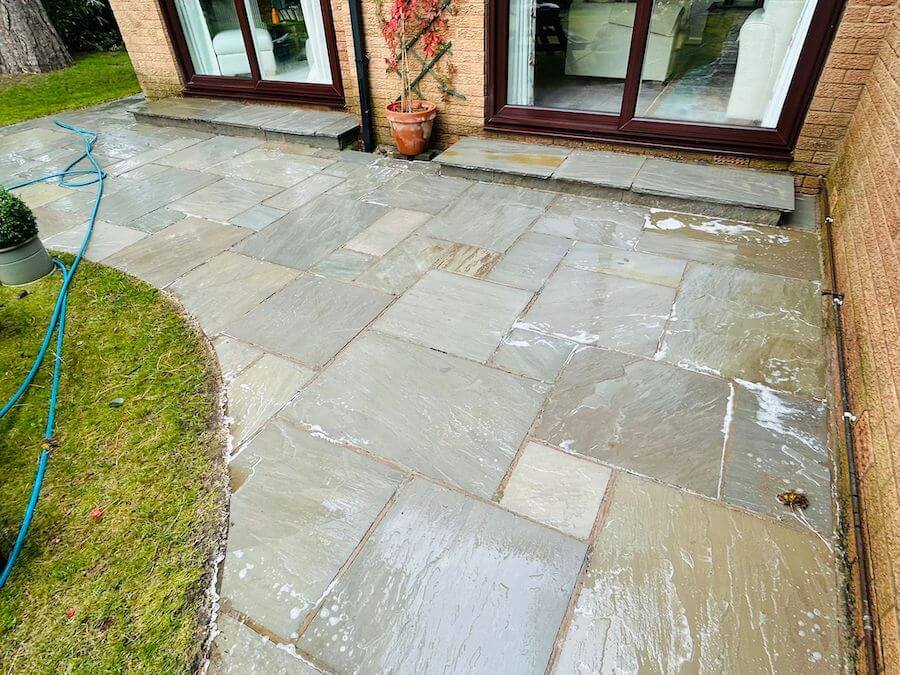Indian stone patios, paths, and garden features bring timeless beauty to any outdoor space. Their natural texture and rich hues make them a popular choice for adding elegance and durability to a garden. But as winter approaches, they face unique challenges—especially from pesky tree sap and algae. If you’ve been wondering whether it’s worth the effort to clean your Indian stone before the colder months hit, here’s why it’s absolutely advantageous to do so.
Improving Safety by Preventing Slips
Winter often means icy and wet conditions, which can make outdoor surfaces dangerously slippery. Algae and tree sap add another layer of slickness, turning beautiful Indian stone into a potential hazard. Algae, in particular, creates a slimy green film when damp, which becomes even more treacherous when ice forms over it. Cleaning these growths off your stone surface makes paths and patios safer for you, your family, and your guests all winter long.
Reducing the Risk of Freeze-Thaw Damage
Winter weather isn’t just harsh on people; it’s tough on stone too. Algae and sap tend to trap moisture on the stone surface. As temperatures drop, any lingering water on the surface or within small cracks can freeze and expand, leading to a phenomenon known as freeze-thaw damage. Over time, this can cause cracking, chipping, and erosion of your Indian stone. By cleaning off algae and sap, you minimize moisture on the stone’s surface, reducing the risk of winter weather taking a toll on your outdoor investment.
Preserving the Natural Beauty of Indian Stone
One of the main reasons people love Indian stone is its unique and natural beauty. When algae or sap covers your stone, it loses that beautiful, clean look and takes on a dull, greenish appearance. During winter, when daylight is limited, algae growth slows, making it the ideal time to clean your stone and let its natural hues shine. Keeping it clear of organic stains helps preserve that elegant look through the season, so it’s ready to impress even in winter’s darker days.
Making Spring Cleaning Easier
Algae loves damp, shaded environments, which makes springtime its ideal growth period. By removing algae and sap before winter, you minimize the organic buildup that would otherwise encourage regrowth when conditions warm up. This not only keeps your stone looking better over the winter but also makes spring cleaning far easier. A clean slate in winter leads to less buildup overall, helping your stone patio or path stay low-maintenance and fresh as temperatures start to rise.
Protecting Your Investment
Indian stone is a high-quality material, and as with any investment, proper care is essential for maintaining its longevity and appearance. Regular maintenance helps prevent costly repairs or replacements down the line. By keeping your stone free of damaging organic growth, you’re helping to protect your investment so it lasts for years to come—without the worry of winter wear and tear cutting its lifespan short.
Tips for Cleaning Indian Stone Before Winter
- Use a Mild Cleaner: Opt for a cleaner specifically designed for natural stone to avoid damage.
- Soft Brushing: Use a soft brush to scrub away algae and sap. Harsh scrubbing can wear down the stone’s surface.
- Rinse Thoroughly: After cleaning, rinse the stone well to remove any residue that could attract more dirt or moisture.
- Consider a Sealant: For added protection, apply a stone sealant to create a barrier against moisture, sap, and algae.
Winter may seem like a time to focus on cozying up indoors, but a bit of preparation for your outdoor stone surfaces can go a long way. Removing algae and tree sap from your Indian stone now can enhance safety, prevent costly damage, and keep your outdoor space looking pristine even as the cold sets in. Give your stone the care it deserves before winter fully arrives, and you’ll enjoy the benefits all season long and beyond!






